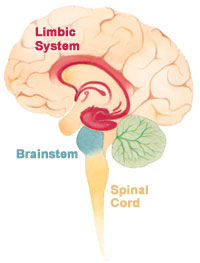
Yesterday, I finished reading John Medina's new book:
Brain Rules - 12 Principles for Surviving and Thriving at Work, Home and School. Compliance with these rules spells the end to our pervasive use of classrooms and cubicles. Dr. Medina lectures college students in classrooms, and thus limits much of his exploration of the implications of these brain rules to improving the attention and retention of his students. Promoters and profiteers of formal education will inevitably find these rules to be bad science, over-generalizations or faddish proclamations. Most educators are acting in defiance of these rules and playing by a very different set of rules. For a synopsis of the 12 rules in the book, see
Angela Maiers's post that got me inspired to read the book in the first place (Thanks
Angela!) Here I'll present the opposite set of rules that are adhered to religiously in anti-learning ecologies.
1. Minimize blood flow to the brain and aerobic breathing by immobilizing the learners. Foster the accumulation of free radicals in the neurons which impair brain functions. Reduce the oxygenation of the brain by long periods of "seat time" and sedentary "activity".
2. Diminish our specie's chances of survival which depend on our recognizing errors and then trying something different. Go to the opposite extremes of repeating experiences with no experimentation and experimenting wildly with no experience. Carefully avoid the recognition of "mistaken approaches to teaching/learning" made evident by experiences with how learners feel about, react to, experience the effects -- of what gets presented to them.
3. Assume every brain gets wired the same, develops through the same progressions and conforms to the same functional patterns. Recognize deviance as deformity while cultivating functionality as conformity. Disregard the unique developments inherent in brain responses to life experiences.
4. Undermine everyone's ability to pay attention (give people "attention deficit disorder" whenever possible.) Expect learners to pay focused attention without context, the gist of it or a story-line of some kind. Expect their paying attention to be very logical and unemotional. Undermine concentration with "multi-tasking" distractions as if it takes no time and energy to get back into a focus. Force learners to pay attention after they naturally "zone out" from more than ten minutes on the same old thing.
5. Give learners useful information in a place where they will never use it again. Help them anchor what they're learning in useless vistas like the neck of the person sitting in front of them, the flag pole holder in the front of the room or the wastebasket next to the teacher's desk (how symbolic!). Make what they're to retain so "easy to remember" that it's meaningless, devoid of context and reduced to pure abstractions.
6. Expect learning to occur from new information. Regard repetition as useless, inefficient and boring. View those learners who rehash, ruminate and revisit new ideas as "slow on the uptake" or "obsessive about recalling facts for game shows".
7. Maximize sleep deprivation whenever possible. Interfere with the intense processing of new experiences that occurs during sleep. Obstruct our physiological need for short, afternoon naps. Put everyone on the same schedule to the detriment of every early riser and night owl.
8. Convince learners they are trapped in adverse circumstances deemed necessary by authority figures. Stress them under conditions where they are powerless to escape, make changes or take out the stressor. Torment them with so much adversity that their ability to perform collapses into a state of despair. Provide relentless pressures to induce chronic anxiety whenever possible. Disable their immune systems in the process.
9. Seek the effects of sensory deprivation through the consistent presentation of talking heads, text-laden slides and printed materials. Avoid any visual movement, auditory stimulation or involvement of touch, taste and smell. Give the learners the look of stunned, floored or wasted individuals by acting as-if they do not come equipped with five, highly integrated, senses.
10. Give the eyes a picture that nothing is happening and there's nothing to follow along as it changes. Give the eyes the same thing to look at so it becomes necessary to look away, daydream or check out all the mating possibilities in close proximity. Assume the learners' eyes are seeing what's objectively in front of them, and not some subjectively distorted picture under the influence of their past experiences or personally unresolved issues.
11. Expect brain development to be the same in males and females even though the X chromosomes that are largely responsible differ between the genders. Disregard how males get all their X chromosomes from their mothers while females get one from each parent. Downplay the advantages of females having two X chromosomes, with one as backup in case of genetic damage that could produce brain deformities.
12. Expect learners to do as you say, not do as you do by natural imitation learning. Hope the learners are not exploring your every move, motivation and mental excursion as they experiment with how to be in the world. See the learners as passive recipients of expert information, not adventurers on quests to realize grander possibilities in their lives.
When does detention begin for all these "rule breakers"?





